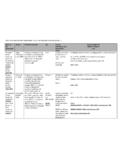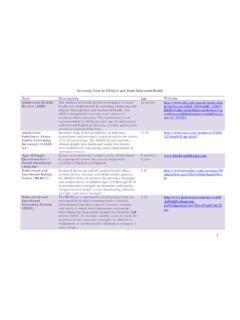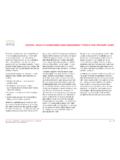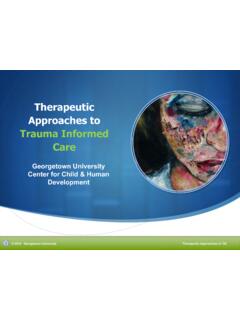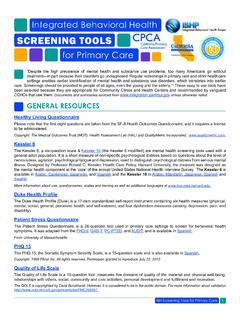Transcription of Assessment Tools for Children’s Exposure to Violence 2016
1 Assessment Tools FOR. children 'S Exposure TO Violence . Written By: Linda Chamberlain, PhD, MPH. 2016 Futures Without Violence . All Rights Reserved I. INTRODUCTION. This document provides an update of a review of Assessment Tools for children 's Exposure to Violence that was completed in 2011. The methodology for the update, covering the years 2011-2015, is described below. The original methodology for the baseline review is described in Appendix A. The purpose of the baseline review was to identify Tools that could be used in pediatric and other child-serving settings to assess children 's Exposure to Violence .
2 Tools to assess for complex trauma, PTSD, and related symptoms were beyond the scope of the review, as were specialized Tools for in-depth Assessment of one type of Exposure such as sexual abuse. Our primary interest was Assessment Tools that had been validated and have some level of evidence to support their use with children . The availability of the Assessment tool was also a consideration. For the purpose of this update, we excluded Tools that could not be obtained for review after multiple contacts to authors/developers. We have expanded the scope of Assessment Tools for this update.
3 First, we searched for Assessment Tools for children 's Exposure to Violence using a parallel process to our original review. Newly identified Tools were added to the alphabetical listing of Assessment Tools for children 's Exposure to Violence in Section III. Influenced by a current movement across the United States to address Adverse Childhood Experiences (ACEs), we also identified and included several adaptations of the ACE questionnaire that are being used in pediatric and child-serving settings. Adaptations of the ACE questionnaire for parents/caregivers and children are described in Section IV.
4 Because of growing interest and emphasis on understanding and measuring resilience, we did a preliminary scan of validated resilience measures for children and parents to determine whether an in-depth review should be considered in the future. A brief summary of this preliminary scan is provided in Section V. About the Author: Linda Chamberlain, MPH. Scientist, author, professor, dog musher, and founder of the Alaska Family Violence Prevention Project, Dr. Linda Chamberlain is an internationally recognized keynote speaker and advocate for understanding the effects of domestic Violence and adverse childhood experiences (ACEs) on brain development and health.
5 She is known for her abilities to translate science into practical strategies for diverse audiences and convey a message of hope and opportunity. Dr. Chamberlain earned public health degrees from Yale School of Medicine and Johns Hopkins University and teaches at the University of Alaska. Her current work focuses on creating Tools that highlight trauma-informed practices for parents, service providers and organizations that work with children and families and communities. Recognition for her work include a National Kellogg Leadership Fellowship, an Alaska Women of Achievement Award, serving as the inaugural Scattergood Foundation Scholar and the Fulbright Arctic Initiative.
6 She lives on a rural homestead outside of Homer, Alaska with her husband and sled dog team. This project was supported by Grant No. 2011-MU-MU-K011 awarded by the Office of Juvenile Justice and Delinquency Prevention, Office of Justice Programs, Department of Justice. Points of view or opinions in this document are those of the author and do not necessarily represent the official position or policies of the Department of Justice. 2. II. REVIEW METHODOLOGY FOR UPDATE. The following strategies were used to identify Assessment Tools for childhood Exposure to Violence , including those related to both Adverse Childhood Experiences (ACEs) and measures of resilience: A.
7 Literature Review Three separate series of searches were conducted in Entrez PubMed and Academic Search Premier databases to identify journal publications on Assessment and screening Tools for childhood Exposure to Violence , ACE-related questionnaires for children and parents, and resilience measures. Additional articles were identified during reviews of publications and references. B. Online Resources The National Child Traumatic Stress Network (NCTSN) review of standardized measures to assess complex trauma, which includes some measures of childhood Exposure to Violence /history, was reviewed to determine if any new measures were available since the baseline review in 2011 ( complex-trauma).
8 Other online resources were included in the baseline review (see Appendix A), such as the California Clearinghouse on Evidence-Based Practices ( ) and the Friends National Center for Community-Based Child Abuse Prevention ( ). C. Experts The following experts in the field of childhood Exposure to Violence /trauma were contacted to ask about Assessment Tools they have developed, used, or recommended: Dr. Megan Bair-Merritt Dr. Ellen Perrin Dr. Christopher Blodgett Dr. Linda Liebenberg Betsy McAllister-Groves, LCSW. 3. III. OVERVIEW OF Tools TO ASSESS children 'S Exposure TO Violence /TRAUMA.
9 Review of hundreds of abstracts, identified with a wide range of search terms in literature searches, yielded two Assessment Tools that had not been previously identified in our baseline review and were also not related to Tools measuring Adverse Childhood Experiences (ACEs). One tool , the SEEK Parent Questionnaire, was added to the review. Publications about the second Assessment tool , Dimensions of Stressful Events Rating Scale (DOSE) indicated that DOSE was designed to assess aspects of stressful experiences that are likely to increase the chance of posttraumatic stress reactions versus screening for Exposure or symptoms.
10 Several attempts to contact authors to obtain the instrument were not successful. Since DOSE was not available for review and did not appear to be an Assessment tool for Exposure , it was excluded from our review. Two additional Assessment Tools were identified during reviews of web-based resources and contacting experts in the field: the NSLJHS Trauma History Checklist (THC) and Interview and the Survey of Well-Being of children (SWYC). The THC is a self-report tool used with adolescents, while the SWYC is a series of screening Tools for parents of young children .

